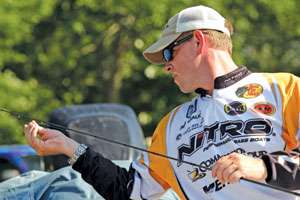
Solving the mystery of the rise and fall of water presents the greatest challenge for bass anglers on a river controlled by a lock-and-dam system.
"Nothing is guaranteed to be the same from day to day," stated Jami Fralick, a Bassmaster Elite Series pro who honed his skills on Lewis and Clark Reservoir on the Missouri River in South Dakota.
"The more days you can spend on the river, the better the chances you have to see all the different stages," he added.
Those stages range from the lowest flows to the highest flows.
From his early experiences on the upper Missouri, Fralick learned quickly that the projected daily water releases from dam authorities are about as reliable as weather forecasts.
"Sometimes they'll tell you one thing and it will be something different," Fralick smiled.
That was certainly the case at Lewis and Clark during the B.A.S.S. Federation Nation Central Divisional presented by Yamaha Outboards and Skeeter Boats. Water authorities announced they would have a "normal release" throughout the tournament. But it was anything but normal. Competitors navigating the river pool had to dodge sandbars and rockpiles because of low flow.
Fralick knows it's difficult to predict patterns in any river system influenced by a chain of dams. "There are no guaranteed release times," he observed. "Sometimes during the summer, they get on a set pattern where they're generating water from noon until midnight every day."
And even with a somewhat reliable release schedule, determining where to begin fishing is often a tough proposition.
To illustrate, he pointed to the generating schedule of the U.S. Army Corps of Engineers at Fort Randall Dam above Lewis and Clark. There, current will still be coming down the river at the Lazy Acres area (about 25 miles below the dam) until midnight of the next day.
While water releases are unpredictable, however, determining where fluctuations will be the greatest — and least — on a river system is much easier.
"The farther up the river [toward the dam] you go, the greater the fluctuation is," said Fralick.
For example, on Lewis and Clark, the water level can drop 2 to 3 inches a day in the Springfield area about 45 miles downstream from the Fort Randall Dam. But 10 miles up the river at Running Water, the water level can fall 2 to 10 inches; and at Lazy Acres (10 miles farther up the river), that drop can be 2 to 20 inches.
Studying navigation charts prior to a tournament helps Fralick pinpoint the best spots to fish during releases on an unfamiliar river system. Map study also reveals the navigational hazards, such as sandbars and gravel bars, when the river flow is below normal.
"If they are releasing water, fish the top and the bottom end of the channel swings where the current leaves one bank and goes across to the next," advised Fralick.
"The first 50 to 75 yards where the channel leaves the one bank, there will be an eddy; and there will be another eddy before it hits the far bank. So even if you know nothing about fishing a river with current, those are the first places you can look for on a map."
Topo maps will also show the mouths of tributaries and sloughs, which are key holding areas for bass migrating in and out of the backwaters.
Still, personal observations of the river provide Fralick with the most reliable water flow information for establishing his game plan and developing patterns.
f he has a good practice day, when he comes back to the ramp he will walk along the river bank and mark a spot to determine the water level. The marked spot then serves as his daily gauge for determining the water level and how good or bad the fishing will be that day.
"The more consistent the release, the better the fishing. Rising water always makes them bite. But once they shut that current off, the fish do not bite."
While he's on the water, Fralick can rely on sandbars as gauges to determine fluctuating water levels. He pays close attention to niches in the sandbar to tell him whether the spot is worth fishing. If he sees water coming over the sand into the niches, he knows the water is rising and the fish will start biting. Fralick usually moves to another area if he notices the water is dropping.
"Going with the flow" is Fralick's best way to determine if the current is the ideal speed for activating bass.
"The easiest way to test the current is to point the boat downstream, let the current push you and look at what the flow rate is on your GPS, which is usually pretty accurate," he said.
"If you are fishing a reservoir that is really affected by current like Lewis and Clark for the first time and the current is flowing 4 to 5 miles per hour, you want it to stay at that speed."
According to Fralick, a 4 to 5 mph current is usually ideal in most river systems. This speed creates eddies behind current breaks where bass stack up in slower moving water.
"You know exactly where the fish are going to be and you can almost call your shots," he said.
If the current speeds up to 6 or 7 mph, however, bass seem to pull tighter to the bank and tuck into unreachable areas, he added.
Fishing a river system becomes toughest when the flow slows to 2 to 3 mph. This tends to scatter bass. "They don't have to hold onto structure anymore. They suspend off the bank and do whatever they want to do."
Current determines success or failure in a system controlled by locks and dams. The optimum condition for bass fishing is a steady current. The trick is knowing how to gather that information and where to look. Likely hot spots inside a fluctuating river are channel swings, sandbars and gravel bars, and the entrances to backwater areas and tributaries, according to Fralick. Using navigational charts to help find potential hot spots when a river fluctuates, Fralick seeks eddy areas and monitors the current's speed using GPS technology.
Surfing for current information
You can get a general idea about water releases and fluctuations on unfamiliar rivers by checking the daily river level statistics.
B.A.S.S. pro Jami Fralick recommends visiting Web sites of agencies such as the U.S. Army Corps of Engineers (www.usace.army.mil), the Tennessee Valley Authority (www.tva.gov) or any other agency that controls dam operations. Through the Internet, you can obtain information about a river's daily pool levels and water discharge rates measured in cubic feet per second (CFS).
If a website is unavailable, local newspapers also list the projected daily discharge and release rates.
Checking the various pool levels of the river can give you some clues about future releases, as well, according to Fralick. "If the pool level above is high, you have to assume there will be a pretty steady flow coming out. As long as that pool is above normal, [dam operators] are going to try to get it down to a normal pool.
"If the pool above is low, it's not as predictable what they're going to do. If the pool you intend to fish is high, they will shut off the pool above and release water from your pool. And if the river below that pool is high, they could hold both dams back."
Fralick's river rules
Making long runs seems necessary for river tournaments.
Yet the rise and fall of a lock-and-dam river dictates where bass bite best, sometimes making the long run unnecessary and unproductive.
When all the dams on the river are releasing water to create a stable current throughout the system, you can fish just about anywhere inside any pool. Most anglers believe the best section is usually in the upper end of that pool.
But if the dam on the lower end is discharging and the upper dam is releasing water, Jami Fralick usually fishes as close to the lower dam as possible.
"You want to be closer to the lower end of the lake because you will still have current and you will still have more of a stable water level," he explained.
As river conditions become steady for several consecutive days after intermittent releases on each end, Fralick said he looks for bass in the backwaters on the lower half of the pool.
| For more great stories and the latest bass fishing news, subscribe to B.A.S.S. Times. Call 877-BASS-USA to order today. |





